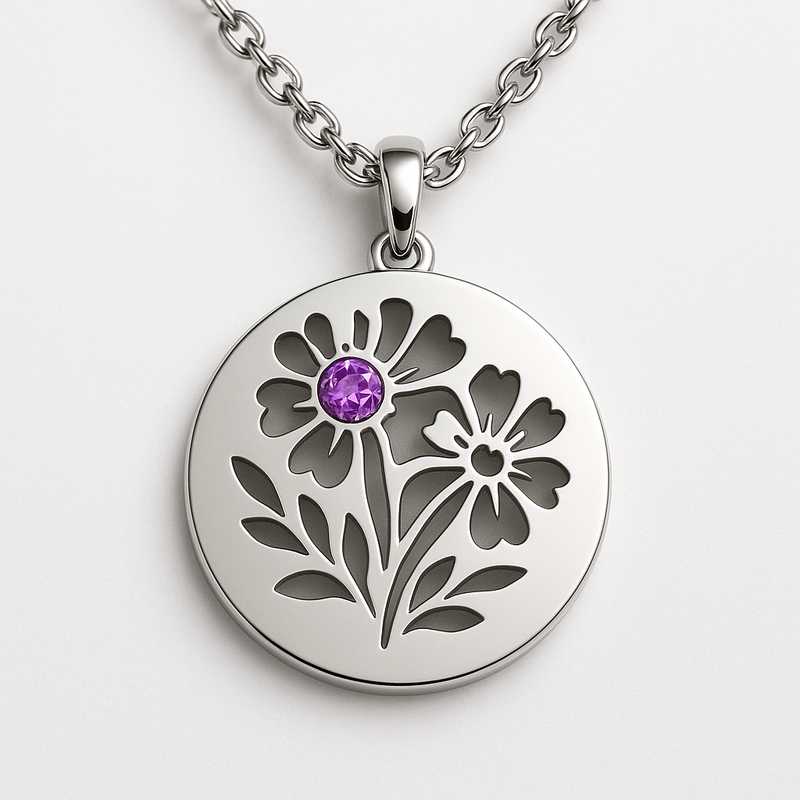Engineered Elegance: Advanced Stainless Steel Charm Crafting

Explore 304 vs. 316L stainless steel, laser tech, corrosion artistry & green OEM/ODM necklace production
In the world of custom jewelry manufacturing, achieving harmony between durability, aesthetic finesse, and eco-conscious processes is an art in itself. The custom birth month flower birthstone charm necklace represents not just a personal accessory but a fusion of material science and innovative craftsmanship. For B2B clients exploring OEM/ODM stainless steel jewelry, understanding the nuances of material performance and advanced manufacturing techniques is crucial for building collections that withstand both time and trend.
Material Mastery: 304 vs. 316L Stainless Steel in Jewelry Applications
When selecting materials for charm necklaces, the choice between 304 and 316L stainless steel often defines the product’s longevity and appeal. 304 stainless steel offers excellent corrosion resistance, making it suitable for everyday wear in moderate conditions. It balances affordability with durability, making it a preferred option for large-scale production runs of birthstone and floral charms.
316L stainless steel, on the other hand, elevates corrosion resistance due to its higher molybdenum content. This makes it ideal for necklaces that may be exposed to saltwater, sweat, or harsh environmental factors. For example, beachside souvenir collections or fitness-inspired jewelry lines often favor 316L for its hypoallergenic properties and resistance to pitting. Its low carbon content also enhances weldability, critical for intricate charm settings in custom birth month flower designs.
Application Scenarios:
- 304 Stainless Steel: Corporate gift lines, seasonal collections, and entry-level designer collaborations focusing on affordability without compromising quality.
- 316L Stainless Steel: Premium OEM/ODM lines, luxury gift programs, and designs targeting activewear or water-related lifestyles requiring maximum corrosion resistance.
Precision Engineering: Laser Cutting and Hydraulic Processes
Creating delicate birth month flower motifs and gemstone settings demands precision beyond traditional cutting methods. Laser cutting technology enables micro-accuracy, producing clean edges and intricate details without inducing stress into the metal. This is especially vital when crafting petals and delicate filigree for floral charms that pair with birthstones.
Hydraulic forming processes complement laser technology by shaping stainless steel with uniform pressure, preserving metal integrity while achieving complex three-dimensional forms. For B2B clients, this combination ensures consistent quality across high-volume OEM runs while maintaining the custom feel of bespoke jewelry.
Case Example: A recent collaboration with a boutique retailer leveraged laser-engraved birth month flower outlines paired with hydraulically domed settings to create a series of customizable charms. The result: a lightweight yet structurally robust collection that maintained intricate detailing even after thousands of units were produced.
Corrosion Artistry: Designing with Patterns and Protective Finishes
Beyond functional resistance, corrosion can be transformed into a design feature through controlled patterning. Chemical etching and selective passivation techniques allow manufacturers to create unique textures that enhance floral designs and gemstone frames. For instance, subtle patina contrasts can highlight engraved birth month flowers against polished backgrounds, giving each necklace a handcrafted aesthetic.
Protective finishing, including PVD coatings and advanced polishing, further ensures that both 304 and 316L stainless steel retain their luster over years of wear. These processes are particularly effective in ODM collections where brand consistency and long-term customer satisfaction are critical.
Green Manufacturing: Waste Recycling and Eco-Friendly Electroplating
As sustainability becomes a cornerstone of B2B jewelry sourcing, adopting environmentally responsible manufacturing practices is no longer optional. Closed-loop waste recycling systems in stainless steel processing minimize material loss, reclaiming up to 98% of offcuts and filings for reuse in subsequent production cycles. This not only reduces costs but also strengthens eco-certifications, appealing to environmentally conscious markets.
Green electroplating technology replaces toxic chemicals with water-based and low-energy alternatives, ensuring vibrant finishes on charms without compromising environmental standards. For example, a large-scale OEM client specializing in personalized jewelry implemented green electroplating for a birthstone charm line, reducing hazardous waste by 70% while maintaining color vibrancy and durability.
Eco-Innovation Example: Implementing ultrasonic cleaning combined with water recycling reduced both water usage and energy consumption, making high-volume ODM birth month flower necklace production more sustainable without sacrificing quality.
Conclusion: Partnering in Innovation and Sustainability
For B2B partners seeking to elevate their custom birth month flower birthstone charm necklaces, mastering the interplay of advanced materials, cutting-edge manufacturing, and eco-conscious practices is key. By understanding the strategic advantages of 304 vs. 316L stainless steel, leveraging laser and hydraulic technologies, embracing corrosion artistry, and committing to green production, your brand can stand at the forefront of innovation and sustainability in the stainless steel jewelry market.
Ready to create your next OEM/ODM masterpiece? Collaborate with our engineering and design team to craft collections that combine engineered elegance with environmental responsibility. Contact us today to start building jewelry that resonates with both style and conscience.
